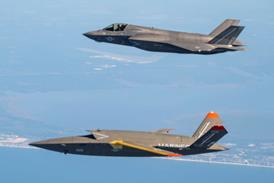In a major evaluation of what the Pentagon has positioned as the future of air combat, Lockheed Martin’s secretive Skunk Works unit has simulated an air-to-air fighter engagement that saw a crewed jet supported by two uncrewed counterparts.
Carried out in partnership with the Operator Performance Laboratory at the University of Iowa, the test paired a conventionally crewed Aero Vodochody L-39 Albatros light fighter with two Aero Vodochody L-29 Delfin trainers for a simulated combat engagement.
Significantly, the two L-29s were flown not by human pilots, but autonomously controlled by an artificial intelligence agent. During the sortie, those uncrewed fighters were assigned tasks in real-time by a human battle manager aloft in the L-39.

Commands issued from a touchscreen pilot interface in the L-39 directed the two AI-controlled L-29s to engage two mock enemy jets. Lockheed says the aircraft then worked together to defeat the designated threat using simulated mission systems and weapons.

To control combat manoeuvres, the AI control agent sends commands directly to the autopilot of each aircraft. Lockheed revealed the test on 21 November, saying it was the third air-to-air combat event, but the first to include a real-time human battle manager overseeing the AI’s actions.
John Clark, the general manager of Skunk Works, describes the project as “foundational for the future of air combat”. That future, he predicts, will see crewed and uncrewed systems will work together to execute complex missions.
Earlier this year, Clark revealed previously unknown details about Lockheed’s unsuccessful bid for the US Air Force’s Collaborative Combat Aircraft (CCA) programme, which seeks to deliver the type of autonomous aircraft simulated by the L-29’s in Lockheed’s recent tests.
Clark told FlightGlobal that Lockheed had offered a CCA with higher levels of stealth and survivability – and presumably a higher cost – than the simpler designs from General Atomics Aeronautical Systems and Anduril Industries that were chosen for the first round of contracts.
“Our increment one offering had higher levels of stealth than were necessary in the requirements because of the operational analysis conviction of building something that actually had value to the air force over the long haul,” Clark said in September.
“We gold plated something that they didn’t need gold plated,” he added.
Lockheed expects to shift its focus more toward a low-cost expendable aircraft for the second increment of CCA development, for which the air force is still developing requirements.
However, he also predicts the USAF’s expectations for its autonomous fighter aircraft will continue to grow, with the service seeking to add more capability to each iteration of development.

Elsewhere, the US Air Force and start-up Shield AI are using a modified Lockheed F-16 retrofitted to fly without human input to test a competing AI flight control agent.
That aircraft, which has been designated the X-62 Variable In-flight Simulation Test Aircraft, successfully engaged in within-visual-range combat manoeuvres – better known as dogfighting – against human fighter pilots earlier this year.
Shield AI co-founder Brandon Tseng told FlightGlobal in May that the company’s algorithm showed a strong aptitude for dogfighting, even demonstrating the ability to develop novel tactics no human pilot would likely employ.































